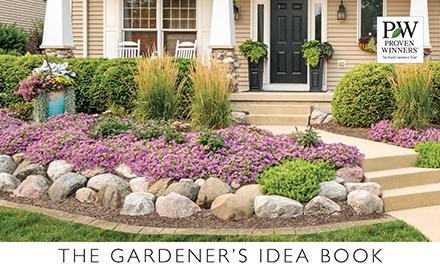Proven Winners Seed-Starter Eco-Pots FAQ

Material
The Proven Winners Seed-Starter Eco-Pots is a compostable garden pot, made out of PLA (polylactic acid). PLA is made from starchy renewable plants like corn, switchgrass, and sugar beets grown right here in the U.S. Starch from these materials is processed into a biopolymer that looks, acts, and performs like its traditional, cousin: petroleum-based plastics.
Proven Winners Eco-Pots have plant nutrients built right into the walls of the container. These organic nutrients are rich in phosphorus, calcium, and nitrogen. As Eco-Pots break down, they release these nutrients and proteins directly into the roots. This helps the plants grow bigger and faster all season long.
Planting and Peeling the Tabs
Ready to plant your Eco-Pots? Peel all 4 tabs off to allow the plant’s roots to develop properly. Transplant entire Eco-Pots and loose tabs into a larger planter or into the ground. Continue to water as needed. If you plan on starting the seeds in the eco-pots but are not ready to transplant them into a larger planter or in the ground, wait until planting before peeling the tabs. This will help the smaller pots from drying out too quickly.
STEP 1: PEEL | STEP 2: PLANT
| STEP 3: WATER Water your plant well after planting. Eco-Pots will naturally disintegrate over time, helping to feed the plant’s roots with nitrogen, phosphorous, and calcium as it does so. |
Eco-Pots Benefits
Prevents stress to the plants by eliminating root disturbance since you can plant the entire plants and Eco-Pots into the ground once the 4 tabs are peeled. With built-in nutrients in the walls of the Eco-Pots container, you won’t have to worry about fertilizer run-off – in addition to remembering to feed your plants weekly!
What happens if parts of my Eco-Pots are still left after the growing season?
Every gardening environment is different in terms of moisture and heat. Your Eco-Pots may break down into very small pieces over a single growing season, or you may have larger segments of your Eco-Pots left. Any product that is still recognizable can be tilled up for nutrients for your next growing season.
Can Eco-Pots go into my local industrial composting bin?
If your area supports industrial composting and you do not want to plant your Eco-Pots in the ground or till it up for next year, you can absolutely put it in your curbside compost bin that gets picked up for industrial composting. This process is where the industrial composter takes and manages all the organics from plant-based plastics, food waste, yard waste, etc., and puts them into windrows. These windrows get to 160 degrees and help break everything down into usable compost.
Remember, these plant-based PLA products continue to get smaller and smaller until microbes consume them and turn them back into inert organic products.
How long do Eco-Pots last above ground with plant/soil in them?
You can plant your seeds in Eco-Pots well before your last frost date without any issue. After about six months of being planted up with soil and seeds, Eco-Pots will begin to turn brittle or soft, so you’ll want to get it planted in the ground by then.
How is plastic made from plants?
Instead of drilling deep into the earth for oil to make plastics, scientists have found a way to break down plants into natural sugars which then can be used to produce a new breed of Earth-friendly plastics called PLA (polylactic acid).
Are the Eco-Pots nutrients safe?
Yes! All Eco-Pots nutrients are natural and organic. Our products are California Prop 65 compliant and all materials are responsibly compounded in the US.
Where are Eco-Pots actually made?
Eco-Pots are proudly designed, manufactured, and assembled responsibly in Stillwater, MN, and shipped directly to you from DeKalb, IL.
What is the shelf life of Eco-Pots if they are not being used?
If you keep them out of the heat, direct sunlight, and moisture, we would estimate a few years. Heat and moisture are the cause of the Eco-Pots breaking down.
What happens if I throw my Eco-Pots into the Landfill?
Do not worry. Eco-Pots will break down faster in the landfill than the traditional petroleum garden pots. Plus, we didn’t need to drill for oil to produce it.
I noticed some Eco-Pots are lighter in color than others. Is this okay?
Yes, not a problem at all. Since Eco-Pots are made from natural materials, there are sometimes variances in the coloration of the PLA material. This will not impact the performance of the Eco-Pots, nor deter plants from growing properly.
Will the corn in the pots effect ones allergies?
Triggers of allergic responses are antigens, often proteins, which can be found in air, food, and water. In the case of corn allergens, profilin, a protein, has been identified in corn and in many other plant (food) extracts. When food is heated past the heat-labile point, its chemical configuration changes. Due to the extreme heat and numerous processing steps to convert corn into the material that is used to make the Eco+ Grande container , it would not contain immunologically reactive profilin and therefore no concerns regarding allergic reactions.
Garden Centers use this link BUY NOW.






